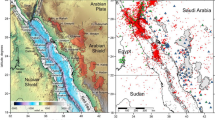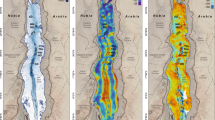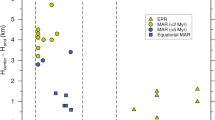Abstract
The Earth's mid-ocean ridges display systematic changes in depth and shape, which subdivide the ridges into discrete spreading segments bounded by transform faults and smaller non-transform offsets of the axis1,2,3. These morphological changes have been attributed to spatial variations in the supply of magma from the mantle, although the origin of the variations is poorly understood1,4,5. Here we show that magmatic segmentation of ridges with fast and intermediate spreading rates is directly related to the migration velocity of the spreading axis over the mantle. For over 9,500 km of mid-ocean ridge examined, leading ridge segments in the ‘hotspot’ reference frame coincide with the shallow magmatically robust segments across 86 per cent of all transform faults and 73 per cent of all second-order discontinuities. We attribute this relationship to asymmetric mantle upwelling and melt production due to ridge migration, with focusing of melt towards ridge segments across discontinuities. The model is consistent with variations in crustal structure across discontinuities of the East Pacific Rise, and may explain variations in depth of melting and the distribution of enriched lavas.
This is a preview of subscription content, access via your institution
Access options
Subscribe to this journal
Receive 51 print issues and online access
$199.00 per year
only $3.90 per issue
Buy this article
- Purchase on Springer Link
- Instant access to full article PDF
Prices may be subject to local taxes which are calculated during checkout




Similar content being viewed by others
References
Macdonald, K. C. et al. A new view of the mid-ocean ridge from the behaviour of ridge-axis discontinuities. Nature 335, 217–225 (1988)
Lin, J., Purdy, G. M., Schouten, H., Sempere, J.-C. & Zervas, C. Evidence from gravity data for focussed magmatic accretion along the Mid-Atlantic Ridge. Nature 344, 627–632 (1990)
Cochran, J. R. & Sempere, J.-C. SEIR Scientific Team. The southeast Indian Ridge between 88°E and 118°E: gravity anomalies and crustal accretion at intermediate spreading rates. J. Geophys. Res 102, 15463–15487 (1997)
Lin, J. & Phipps Morgan, J. The spreading rate dependence of three-dimensional mid-ocean ridge gravity structure. Geophys. Res. Lett. 19, 13–16 (1992)
Wang, X., Cochran, J. R. & Barth, G. A. Gravity anomalies, crustal thickness, and the pattern of mantle flow at the fast spreading East Pacific Rise, 9°–10°N; evidence for three-dimensional upwelling. J. Geophys. Res. 101, 17927–17940 (1996)
Langmuir, C. H., Bender, J. F. & Batiza, R. Petrological and tectonic segmentation of the East Pacific Rise, 5° 30′–14° 30′ N. Nature 322, 422–429 (1986)
Detrick, R. S. et al. Multi-channel seismic imaging of a crustal magma chamber along the East Pacific Rise. Nature 326, 35–41 (1987)
Van Adendonk, H. J. A., Harding, A. J., Orcutt, J. A. & McClain, J. S. Contrast in crustal structure across the Clipperton transform fault from travel time tomography. J. Geophys. Res. 106, 10961–10981 (2001)
Scheirer, D. S. & Macdonald, K. C. Variation in cross-sectional area of the axial ridge along the East Pacific Rise; evidence for the magmatic budget of a fast spreading center. J. Geophys. Res. 98, 7871–7885 (1993)
Cormier, M. H., Macdonald, K. C. & Wilson, D. S. A three-dimensional gravity analysis of the East Pacific Rise from 18° to 21° 30′S. J. Geophys. Res. 100, 8063–8082 (1995)
The MELT Seismic Team, Imaging the deep seismic structure beneath a mid-ocean ridge: The MELT experiment. Science 280, 1215–1218 (1998)
Stein, S., Melosh, H. J. & Minster, J. B. Ridge migration and asymmetric sea-floor spreading. Earth Planet. Sci. Lett. 36, 51–62 (1977)
Small, C. & Danyushevsky, L. V. Plate-kinematic explanation for mid-oceanic-ridge depth discontinuities. Geology 31, 399–402 (2003)
Davis, E. E. & Karsten, J. L. On the cause of the asymmetric distribution of seamounts about the Juan de Fuca Ridge; ridge-crest migration over a heterogeneous asthenosphere. Earth Planet. Sci. Lett. 79, 385–396 (1986)
Schouten, H., Dick, H. J. B. & Klitgord, K. D. Migration of mid-ocean-ridge volcanic segments. Nature 326, 835–839 (1987)
Madge, L. S. & Sparks, D. W. Three-dimensional mantle upwelling, melt generation, and melt migration beneath segment slow spreading ridges. J. Geophys. Res. 102, 20571–20583 (1997)
Kent, G. M. et al. Evidence from three-dimensional seismic reflectivity images for enhanced melt supply beneath mid-ocean-ridge discontinuities. Nature 406, 614–618 (2000)
Forsyth, D. W., Webb, S. C., Dorman, L. M. & Shen, Y. Phase velocities of Rayleigh waves in the MELT experiment on the East Pacific Rise. Science 280, 1235–1238 (1998)
Toomey, D. R., Wilcock, W. S. D., Solomon, S. C., Hammond, W. C. & Orcutt, J. A. Mantle seismic structure beneath the MELT region of the East Pacific Rise from P and S wave tomography. Science 280, 1224–1227 (1998)
Wolfe, C. J. & Solomon, S. C. Shear-wave splitting and implications for mantle flow beneath the MELT region of the East Pacific Rise. Science 280, 1230–1232 (1998)
Conder, J. A., Forsyth, D. W. & Parmentier, E. M. Asthenospheric flow and asymmetry of the East Pacific Rise, MELT area. J. Geophys. Res. 107 doi:10.1029/2001JB000807 (2002)
Toomey, D. R. et al. Asymmetric mantle dynamics in the MELT region of the East Pacific Rise. Earth Planet. Sci. Lett. 200, 287–295 (2002)
Katz, R., Spiegelman, M. & Carbotte, S. M. Ridge migration, asthenospheric flow and the origin of magmatic segmentation in the global mid-ocean ridge system. Geophys. Res. Lett. (submitted)
Canales, J. P., Detrick, R. S., Toomey, D. R. & Wilcock, W. S. D. Segment-scale variations in crustal structure of 150- to 300-k.y.-old fast spreading oceanic crust (East Pacific Rise, 8°15′N-10°15′N) from wide-angle seismic refraction profiles. Geophys. J. Int. 152, 766–794 (2003)
Weiland, C. M. & Macdonald, K. C. Geophysical study of the East Pacific Rise 15° N-17° N; an unusually robust segment. J. Geophys. Res. 101, 20257–20273 (1996)
Hooft, E. E. E. & Detrick, R. S. Relationship between axial morphology, crustal thickness, and mantle temperature along the Juan de Fuca and Gorda ridges. J. Geophys. Res. 100, 22499–22508 (1995)
Hirschmann, M. M. & Stolper, E. W. A possible role for garnet pyroxenite in the origin of the “garnet signature” in MORB. Contrib. Mineral. Petrol. 124, 185–208 (1996)
Gripp, A. E. & Gordon, R. G. Young tracks of hotspots and current plate velocities. Geophys. J. Int. 150, 321–361 (2002)
Donnelly, K. E. The Genesis of E-MORB: Extensions and Limitations of the Hot Spot Model. Thesis, Columbia Univ. (2002)
Su, Y.-J. Mid-ocean Ridge Basalt Trace Element Systematics: Constraints from Database Management, ICPMS Analyses, Global Data Compilation, and Petrologic Modeling. Thesis, Columbia Univ. (2002)
Acknowledgements
We thank R. Katz, M. Spiegelman, R. Buck and W.B.F. Ryan for discussions during the development of these ideas. Special thanks are due to W. Haxby for GeoMapApp, which greatly aided the data analysis. This work was supported by the US National Science Foundation, the Palisades Geophysical Institute, and the Doherty Foundation.
Author information
Authors and Affiliations
Corresponding author
Ethics declarations
Competing interests
The authors declare that they have no competing financial interests.
Supplementary information
Supplementary Figure 1
This figure shows bathymetry and axial depth profiles for the Southern East Pacific Rise and Pacific-Antarctic Rise. (PDF 738 kb)
Supplementary Figure 2
This figure shows bathymetry and axial depth profiles for the Explorer-Juan de Fuca-Gorda Ridges and South East Indian Ridge. (PDF 1339 kb)
Rights and permissions
About this article
Cite this article
Carbotte, S., Small, C. & Donnelly, K. The influence of ridge migration on the magmatic segmentation of mid-ocean ridges. Nature 429, 743–746 (2004). https://doi.org/10.1038/nature02652
Received:
Accepted:
Issue Date:
DOI: https://doi.org/10.1038/nature02652
This article is cited by
-
Generation and evolution of the oceanic lithosphere in the North Atlantic
La Rivista del Nuovo Cimento (2022)
-
Discovery of flat seismic reflections in the mantle beneath the young Juan de Fuca Plate
Nature Communications (2020)
-
Segmentation of mid-ocean ridges attributed to oblique mantle divergence
Nature Geoscience (2016)
-
Long-term interaction between mid-ocean ridges and mantle plumes
Nature Geoscience (2015)
-
Mapping absolute migration of global mid-ocean ridges since 80 Ma to Present
Earth, Planets and Space (2007)
Comments
By submitting a comment you agree to abide by our Terms and Community Guidelines. If you find something abusive or that does not comply with our terms or guidelines please flag it as inappropriate.



